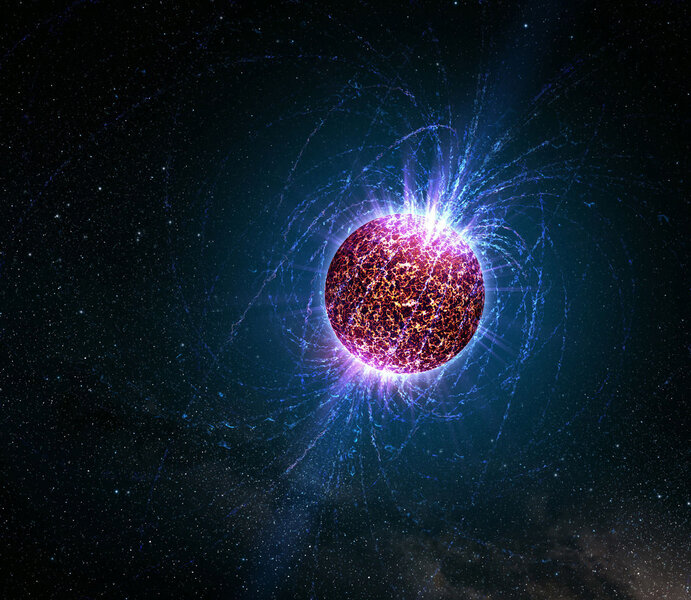Create a free profile to get unlimited access to exclusive videos, sweepstakes, and more!
Are neutron stars blasting out dark matter?

One of the most irritating problems in astrophysics right now can be simply stated: What is dark matter?
Simple questions like that can have seriously complex answers. In this case, a team of theoretical physicists propose that superhot neutron star cores are creating and blasting out axions, which then generate high-energy photons when they interact with the blisteringly powerful magnetic fields surrounding the neutron stars, and that in turn can be seen as an excess of X-rays from them.
See? Complex.
Dark matter is similar to what we think of as normal matter — the kind we're made of — in that is has mass and therefore gravity. But it doesn't emit light and doesn't interact with normal matter, making it the devil's own game to detect. We have plenty of reasons to think it exists, but we've never been able to directly detect it.
A lot of potential dark matter candidates have been eliminated over the years, leaving only ever more exotic possibilities, like subatomic particles that have not yet been discovered.
The leading candidate there is the axion, predicted to exist by current quantum models. They don't emit light, don't interact with normal matter except through gravity, could be extremely abundant in the Universe, and are very elusive. They fit the bill!
So how do you find something that has never been found? You have to look at predicted effects of axions, and see if any of them are observable.
Here's where neutron stars come in, the remnants of massive stars after they explode. While the outer layers of the star get blasted away, the core (up to about 2.8 times the mass of the Sun) collapses, forming an object mostly made of neutrons and only a couple of dozen of kilometers across. This makes them ridiculously dense, hot, magnetically supercharged, and the perfect oven in which to bake axions.
When protons or neutrons in the core of the neutron star pass close to each other, they release energy. Given that the temperature in the core of the star is several billion degrees, that energy can be quite high. Particles can be created out of that energy (that's what E=mc2 is telling us; matter can be converted to energy and vice-versa), and one kind of particle is predicted to be the axion, in copious numbers.
Despite the incredible density of a neutron star (a chunk the size of six sided die would outweigh all the cars in the US combined), the axion will blow right out of the star, because it really doesn't like to interact with matter. However, when it gets to the outside of the star, the immensely powerful magnetic field does affect it. The math is… difficult, but it should convert into energy, creating X-rays.
So, do we just point our X-ray telescopes at neutron stars and see if they emit them? Well, no, because neutron stars are so hot and powerful they emit X-rays all the time. But there's the cool bit: We can calculate how much X-ray emission we expect from them due to their being hot, and see if they emit a lot more than that. We look for an excess of X-rays. If we see it, that might be from axions!
Turns out there are seven neutron stars just perfect for this sort of thing. Called the Magnificent Seven, they're close by (all within roughly 2,000 light years of Earth), isolated, and cooling after their own creation event; that is, being at the center of a supernova.
All of them have been observed by X-ray telescopes (specifically Chandra and XMM-Newton) and … all but one seem to have X-ray excesses. Hmmm.
However, of course, there's a caveat. Two of them show clear excesses, more X-ray emission than expected to a statistically significant degree. Another has an excess but it's not as well established statistically. Two more have an excess that is even less significant, and the last has a deficit of X-rays.
Still, that's encouraging. Even better, the two neutron stars with strong excess seem to emit at about the amount predicted by the physicists' axion creation model. Hmmm again.
It's also possible that the ones with less solid excesses may just need to be observed more; taking longer exposures makes it easier to see faint stuff. Also, neutron stars will emit different amounts depending on all sorts of things, including temperature, spin, magnetic field strength, and so on. So it's still possible they're all emitting axions but we can't detect the X-rays well enough yet.
Or, to be careful here, it may be that this has some other explanation entirely and it's not axions at all. Remember, at the moment axions are entirely theoretical. We have good reasons to believe they exist, but nothing has been proven yet.
But this X-ray excess avenue seems to be a good one to travel down. The team talks a bit about what kinds of further observations are needed to help, noting that the proposed European Athena observatory could help nail this down. That is due to launch sometime in the 2030s, so it'll be a while though.
Still, plenty to do before then to help work out the kinks in the observations. Interestingly, there's another way neutron stars can possibly make axions, but observations of that method have come up empty. Other experiments are searching for them too.
I hope they find them. Dark matter is fascinating, and its maniacal dislike of normal matter is amusing as an idea, but getting increasingly irritating observationally as time goes on. Finding them could solve a lot of issue in astrophysics and particle physics.
And if they discover axions don't exist? Well, that would be mighty interesting, too. That means something else is going on in the Universe, and a whole new set of hypotheses would have to be dreamed up to explain it. But for now, we'll stick to one so-far undetected mystery at a time.






























